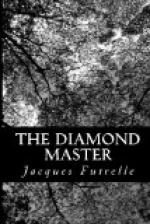Then another idea came. One of the letters, of course! The owner of the diamond had sent it this way, perhaps to be set, and had sent instructions under another cover. An absurd, even a reckless thing to do, but ——! And Mr. Latham attacked the heap of letters neatly stacked up in front of him. There were thirty-six of them, but not one even remotely hinted at diamonds. In order to be perfectly sure, Mr. Latham went through his mail a second time. Perhaps the letter of instructions had come addressed to the company, and had gone to the secretary, Mr. Flitcroft.
He arose to summon Mr. Flitcroft from an adjoining room, then changed his mind long enough carefully to replace the diamond in the box and thrust the box into a pigeonhole of his desk. Then he called Mr. Flitcroft in.
“Have you gone through your morning mail?” Mr. Latham inquired of the secretary.
“Yes,” he replied. “I have just finished.”
“Did you happen to come across a letter bearing on—that is, was there a letter to-day, or has there been a letter of instructions as to a single large diamond which was to come, or had come, by mail?”
“No, nothing,” replied Mr. Flitcroft promptly. “The only letter received to-day which referred to diamonds was a notification of a shipment from South Africa.”
Mr. Latham thoughtfully drummed on his desk.
“Well, I’m expecting some such letter,” he explained. “When it comes please call it to my attention. Send my stenographer in.”
Mr. Flitcroft nodded and withdrew; and for an hour or more Mr. Latham was engrossed in the routine of correspondence. There was only an occasional glance at the box in the pigeonhole, and momentary fits of abstraction, to indicate an unabated interest and growing curiosity in the diamond. The last letter was finished, and the stenographer arose to leave.
“Please ask Mr. Czenki to come here,” Mr. Latham directed.
And after a while Mr. Czenki appeared. He was a spare little man, with beady black eyes, bushy brows, and a sinister scar extending from the point of his chin across the right jaw. Mr. Czenki drew a salary of twenty-five thousand dollars a year from the H. Latham Company, and was worth twice that much. He was the diamond expert of the firm; and for five or six years his had been the final word as to quality and value. He had been a laborer in the South African diamond fields—the scar was an assegai thrust—about the time Cecil Rhodes’ grip was first felt there; later he was employed as an expert by Barney Barnato at Kimberly, and finally he went to London with Adolph Zeidt. Mr. Latham nodded as he entered, and took the box from the pigeonhole.
“Here’s something I’d like you to look at,” he remarked.
Mr. Czenki removed the cover and turned the glittering stone out into his hand. For a minute or more he stood still, examining it, as he turned and twisted it in his fingers, then walked over to a window, adjusted a magnifying glass in his left eye and continued the scrutiny. Mr. Latham swung around in his chair and stared at him intently.




